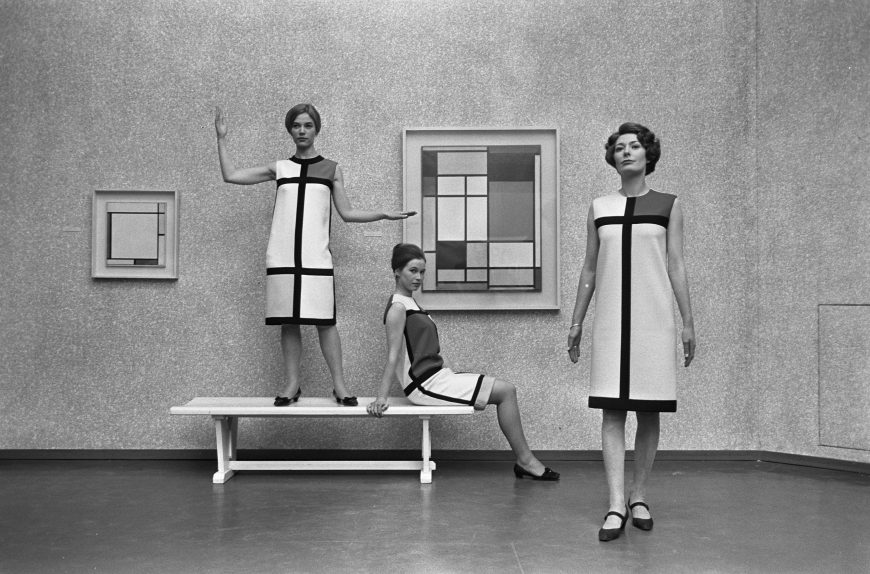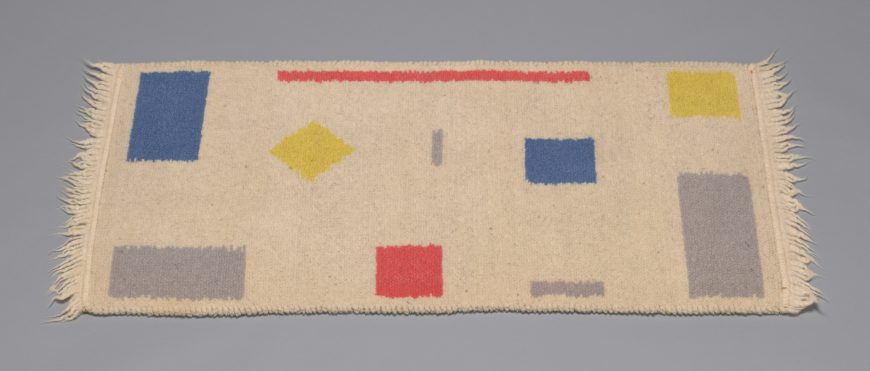In 1965, French fashion designer Yves Saint Laurent created a set of six cocktail dresses in the style of Piet Mondrian, using only red, yellow, blue, and white rectangles bounded by black horizontal and vertical lines. The cut of the dresses was A-line, with no darts or belt, and the weight of the fabric was calculated to ensure that it hung straight, with minimal wrinkling or movement. Today, an internet search for “Mondrian car,” “Mondrian chair,” “Mondrian tea towel,” and the like will find any number of De Stijl-inspired home products for purchase.
A universal style
While it may seem like crass commercial exploitation to see the pure, spiritual art of De Stijl applied to product design, in a way it actually serves to fulfill the ultimate long-term goal of the movement, which was to make the style truly universal. Mondrian wrote many essays discussing how De Stijl could be seen in modern architecture, product design, city planning, and even music.
Similarly, Theo van Doesburg, editor of the journal De Stijl, was an architect who preferred to design total environments, including the furniture and wall decoration. Bart van der Leck, one of the co-founders of De Stijl (although he refused to sign their “manifesto”), designed De Stijl-inspired stained glass, a typeface, and posters, as well as hangings and carpets sold by the Dutch department store Metz & Co.
Provided that all of these products not only use the elements of De Stijl, but are also composed in a way that is sensitive to the sort of harmonious balance sought by Mondrian and his fellow artists, this expansion beyond the museum painting and into the terrain of everyday life is entirely appropriate.
Entering paradise
If a single De Stijl painting represents an oasis of absolute purity and harmony in a world that is woefully short of both of those qualities, and if an encounter with a De Stijl painting can help to purify and harmonize the human spirit, think how it would be to live in an entire De Stijl environment.
Mondrian himself sought to move beyond the isolated easel painting. Although there are inevitable aesthetic compromises that come with designing architecture, enough purity and harmony can be retained that the individual living in an entire De Stijl environment will be, in Mondrian’s words, “uplifted through beauty toward universal life.” [1]
When Mondrian moved back to Paris following the end of World War One, he painted all of his furniture white and decorated the walls with planes of colored card stock. His friend Maud van Loon described the effect of coming into this space as a spiritual oasis:
The stairwell was horrific, terribly shabby, unsightly … Then you walked through his door and into a brilliantly white studio with a color plane here and there. As you stepped inside, you were in Paradise.Cited in Cees de Jong, ed., Piet Mondrian: The Studios (London: Thames & Hudson, 2015), p. 96.
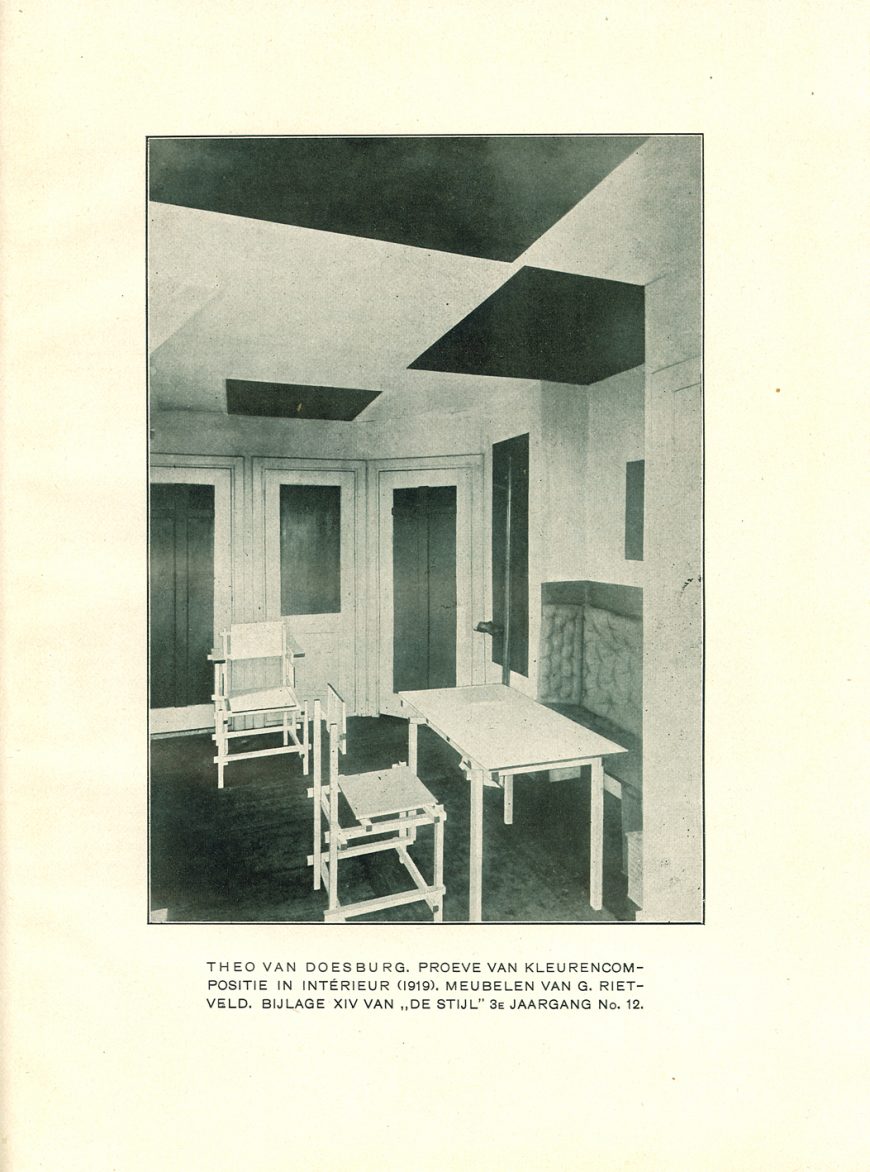
Theo van Doesburg, Test of Color Composition with furniture by Gerrit Rietveld, in De Stijl 3, no. 12 (November 1920)
De Stijl architecture
Architecture and interior design were important to De Stijl from the beginning, and in fact architectural renderings dominate the illustrations in the short-lived journal dedicated to the movement, De Stijl magazine. However, in order for architecture to become, in effect, a three-dimensional De Stijl environment, rigorous rules need to be followed.
Ornament must be excluded in order to purify the space as much as possible, so any merely decorative objects or elements must be banished. Functional objects such as chairs and lamps need to be included, of course, but they should conform with the pure elements of De Stijl as much as possible.
Mondrian acknowledged that whereas a painter has total freedom about what shapes to use and where to place them, “Utility or purpose indeed affects architectural beauty … Function can even limit beauty: some utilitarian things … may require a round form, although the straight expresses the profoundest beauty.” In such cases, the designer should use “a pure circle, which is far from capricious nature” and closer to the rigorous geometric purity of De Stijl.[2]
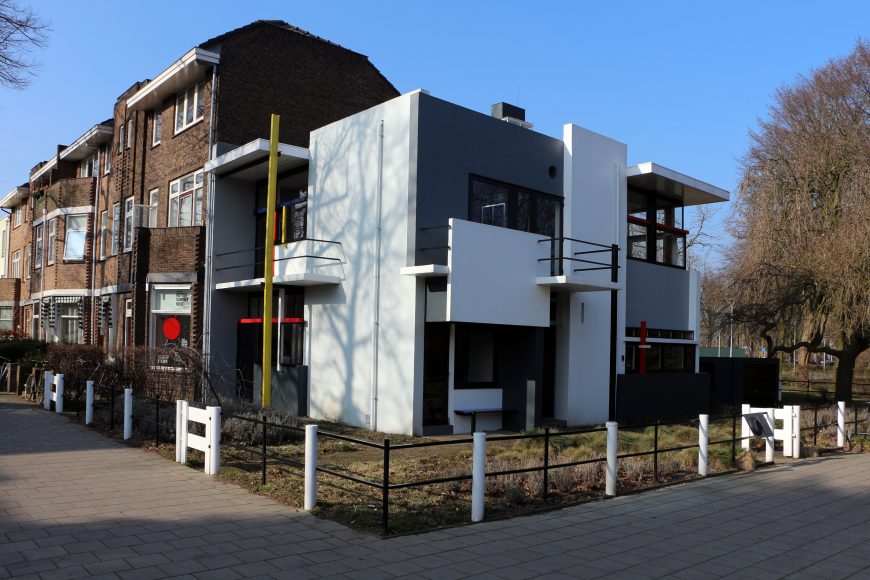
Gerrit Rietveld, Schröder House, exterior, 1924 (photo: Sailko, CC BY 3.0)
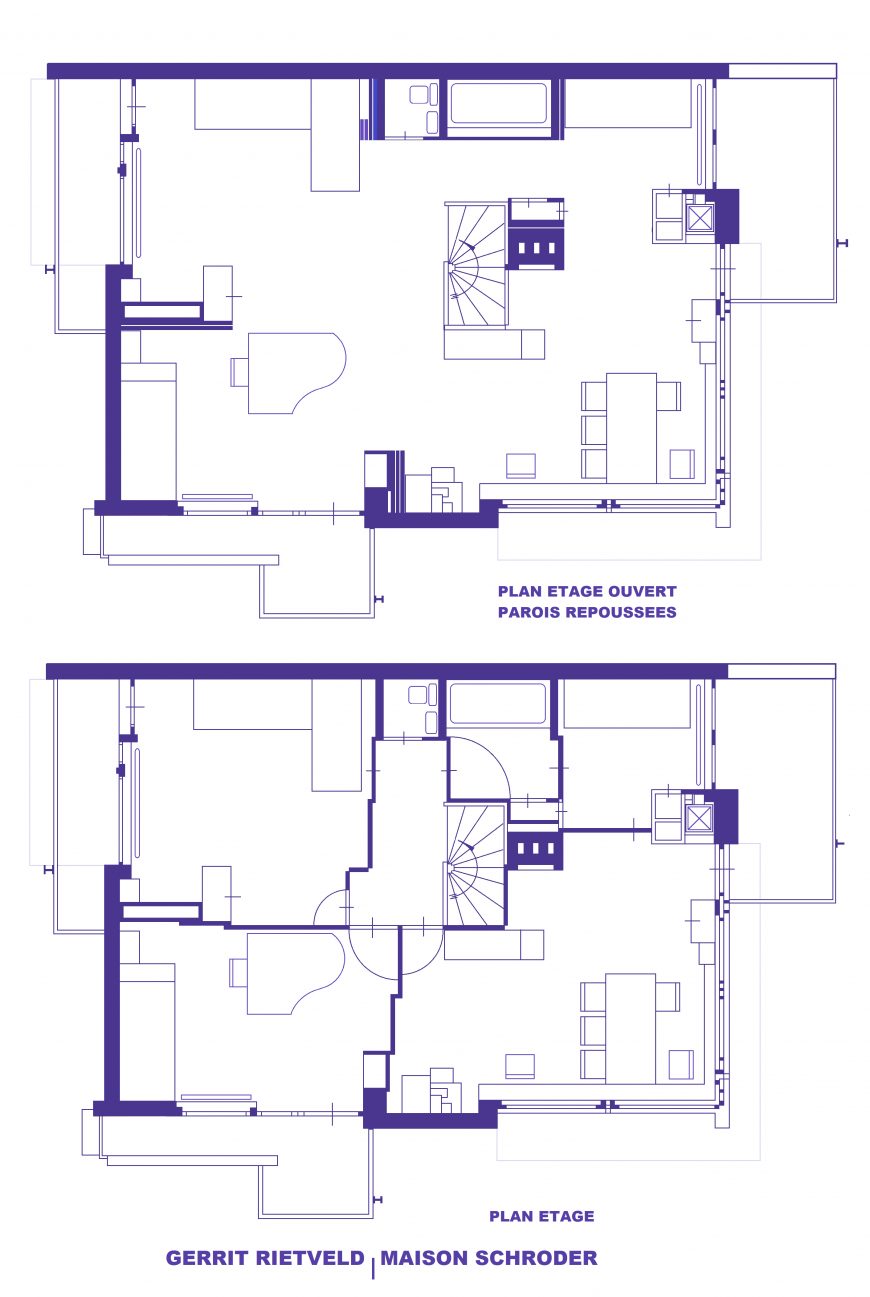
Schröder House, floor plans, 1924 (image: Jchancerel, CC BY-SA 4.0)
Rietveld’s Schröder House
The best-known example of a total De Stijl environment is Gerrit Rietvelt’s Schröder House (1924). Commissioned by Truus Schröder, a recently widowed mother of three, the house clings oddly to the end of a street of row houses in Utrecht, The Netherlands. Its exterior is composed entirely of white and neutral gray rectangular planes, punctuated by horizontal and vertical linear elements in black, red, yellow, and blue.
One of the architect’s intentions was to integrate the house with its environment, so entire walls and even corners are opened up by windows and French doors. The interior was also designed to be open, especially on the top floor, which had sliding panels that could create separate rooms or one flowing space.
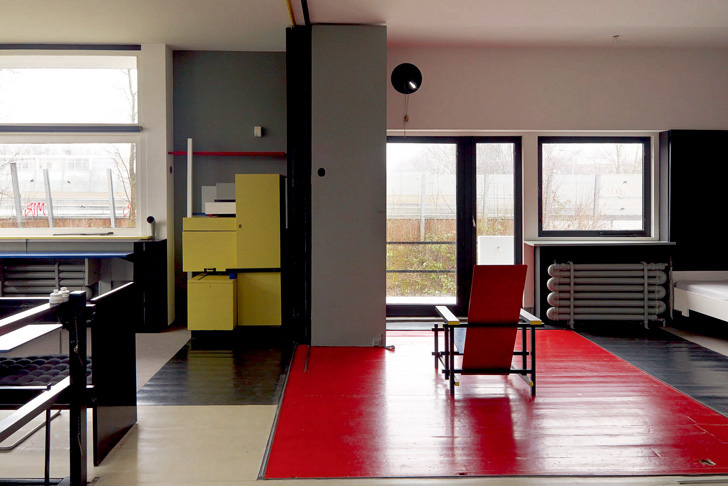
Schröder House, interior, top floor, 1924 (photo: Inhabitat, CC BY-NC-ND 2.0)
Rietveld also designed as much of the interior and furnishings as possible using the basic tenets of De Stijl. A hanging lamp seems to demonstrate the three dimensions of space: length, width, and height, and is so stripped of unnecessary ornament that it hangs from its own electric cords. His famous Red Blue Chair shows an element of the compromise that Mondrian noted for designing functional objects. A perfectly horizontal seat and perfectly vertical back would be extremely uncomfortable, so Rietveld tilted both slightly to accommodate the organic imperfection of the human body. But the armature of the chair is made of modular beechwood slats oriented in the three dimensions, and of course all is painted in pure De Stijl red, blue, yellow, and black.
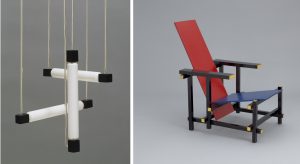
Left: Gerrit Rietveld, Hanging Lamp, 1920, Wood, glass, and tubular bulbs, 104.1 x 40 x 40 cm, (MoMA). Right: Gerrit Rietveld, Red Blue Chair, 1918-23, painted wood, 86.7 x 66 x 83.8 cm (MoMA).
The individual and the universal
De Stijl was one of a number of modern movements that believed its utopian aspirations would be best achieved by creating total environments, over which the designer (not the inhabitant) had complete control. As we imagine living in Rietveld’s Schröder House, we may be put off, not only by the barren minimalism of the hard, geometric surfaces, but also by the total lack of individual personality or whimsy. These are environments to which the occupant is expected to conform, rather than adapting the decor to fit the individual tastes of the occupant.
What may appear repugnant in our era, which prizes individual differences and self-expression, was actively embraced by many modern architects and designers. For Mondrian, “If our material environment is to be pure in its beauty and therefore healthy and practical, it can no longer be the reflection of the egotistic sentiments of our petty personality.” If a total De Stijl environment were to expand from the painting, to the home or office interior, to the street and city itself, then all individual components of the environment must be subsumed to an overarching, homogeneous design. Mondrian continues, “And man? Nothing in himself, he will be part of the whole; and losing his petty and pathetic individual pride, he will be happy in the Eden he will have created!”[3]
Notes:
- Piet Mondrian, “Neo-Plasticism: The Home – The Street – The City,’ in De internationale revue i10 (Amsterdam, 1927), as translated in Harry Holtzman and Martin S. James, eds. and trans., The New Art – The New Life: The Collected Writings of Piet Mondrian (New York: Da Capo Press, 1993), p. 208.
- Piet Mondrian, “The Realization of Neo-Plasticism in the Distant Future and in Architecture Today,” originally published in De Stijl (March and May, 1922), as translated in The New Art – The New Life, p. 171.
- Piet Mondrian, “Neo-Plasticism: The Home, The Street – The City” (1926), as translated in The New Art – The New Life, pp. 208, 212.
Additional Resources:
Nancy J. Troy, The De Stijl Environment (Cambridge, MA and London: The MIT Press, 1983).
Cees W. De Jong, ed. Piet Mondrian: The Studios (London: Thames & Hudson, 2015).

